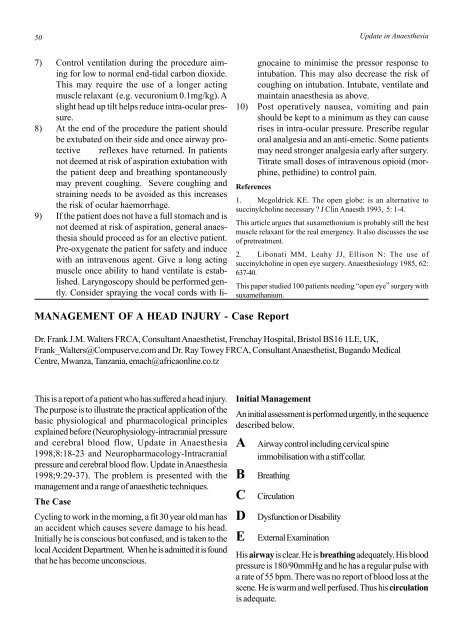Download Update 11 - Update in Anaesthesia - WFSA
Download Update 11 - Update in Anaesthesia - WFSA
Download Update 11 - Update in Anaesthesia - WFSA
You also want an ePaper? Increase the reach of your titles
YUMPU automatically turns print PDFs into web optimized ePapers that Google loves.
50<strong>Update</strong> <strong>in</strong> <strong>Anaesthesia</strong>7) Control ventilation dur<strong>in</strong>g the procedure aim<strong>in</strong>gfor low to normal end-tidal carbon dioxide.This may require the use of a longer act<strong>in</strong>gmuscle relaxant (e.g. vecuronium 0.1mg/kg). Aslight head up tilt helps reduce <strong>in</strong>tra-ocular pressure.8) At the end of the procedure the patient shouldbe extubated on their side and once airway protectivereflexes have returned. In patientsnot deemed at risk of aspiration extubation withthe patient deep and breath<strong>in</strong>g spontaneouslymay prevent cough<strong>in</strong>g. Severe cough<strong>in</strong>g andstra<strong>in</strong><strong>in</strong>g needs to be avoided as this <strong>in</strong>creasesthe risk of ocular haemorrhage.9) If the patient does not have a full stomach and isnot deemed at risk of aspiration, general anaesthesiashould proceed as for an elective patient.Pre-oxygenate the patient for safety and <strong>in</strong>ducewith an <strong>in</strong>travenous agent. Give a long act<strong>in</strong>gmuscle once ability to hand ventilate is established.Laryngoscopy should be performed gently.Consider spray<strong>in</strong>g the vocal cords with lignoca<strong>in</strong>eto m<strong>in</strong>imise the pressor response to<strong>in</strong>tubation. This may also decrease the risk ofcough<strong>in</strong>g on <strong>in</strong>tubation. Intubate, ventilate andma<strong>in</strong>ta<strong>in</strong> anaesthesia as above.10) Post operatively nausea, vomit<strong>in</strong>g and pa<strong>in</strong>should be kept to a m<strong>in</strong>imum as they can causerises <strong>in</strong> <strong>in</strong>tra-ocular pressure. Prescribe regularoral analgesia and an anti-emetic. Some patientsmay need stronger analgesia early after surgery.Titrate small doses of <strong>in</strong>travenous opioid (morph<strong>in</strong>e,pethid<strong>in</strong>e) to control pa<strong>in</strong>.References1. Mcgoldrick KE. The open globe: is an alternative tosucc<strong>in</strong>ylchol<strong>in</strong>e necessary ? J Cl<strong>in</strong> Anaesth 1993, 5: 1-4.This article argues that suxamethonium is probably still the bestmuscle relaxant for the real emergency. It also discusses the useof pretreatment.2. Libonati MM, Leahy JJ, Ellison N: The use ofsucc<strong>in</strong>ylchol<strong>in</strong>e <strong>in</strong> open eye surgery. Anaesthesiology 1985, 62:637-40.This paper studied 100 patients need<strong>in</strong>g “open eye” surgery withsuxamethanium.MANAGEMENT OF A HEAD INJURY - Case ReportDr. Frank J.M. Walters FRCA, Consultant Anaesthetist, Frenchay Hospital, Bristol BS16 1LE, UK,Frank_Walters@Compuserve.com and Dr. Ray Towey FRCA, Consultant Anaesthetist, Bugando MedicalCentre, Mwanza, Tanzania, emach@africaonl<strong>in</strong>e.co.tzThis is a report of a patient who has suffered a head <strong>in</strong>jury.The purpose is to illustrate the practical application of thebasic physiological and pharmacological pr<strong>in</strong>ciplesexpla<strong>in</strong>ed before (Neurophysiology-<strong>in</strong>tracranial pressureand cerebral blood flow, <strong>Update</strong> <strong>in</strong> <strong>Anaesthesia</strong>1998;8:18-23 and Neuropharmacology-Intracranialpressure and cerebral blood flow. <strong>Update</strong> <strong>in</strong> <strong>Anaesthesia</strong>1998;9:29-37). The problem is presented with themanagement and a range of anaesthetic techniques.The CaseCycl<strong>in</strong>g to work <strong>in</strong> the morn<strong>in</strong>g, a fit 30 year old man hasan accident which causes severe damage to his head.Initially he is conscious but confused, and is taken to thelocal Accident Department. When he is admitted it is foundthat he has become unconscious.Initial ManagementAn <strong>in</strong>itial assessment is performed urgently, <strong>in</strong> the sequencedescribed below.ABCDEAirway control <strong>in</strong>clud<strong>in</strong>g cervical sp<strong>in</strong>eimmobilisation with a stiff collar.Breath<strong>in</strong>gCirculationDysfunction or DisabilityExternal Exam<strong>in</strong>ationHis airway is clear. He is breath<strong>in</strong>g adequately. His bloodpressure is 180/90mmHg and he has a regular pulse witha rate of 55 bpm. There was no report of blood loss at thescene. He is warm and well perfused. Thus his circulationis adequate.
















